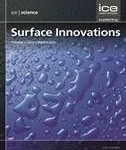The first issue of 2017 of Surface Innovations is available online. We open this first issue with two important contributions prepared by members of the External Advisory Board. In the first paper entitled “Contact Angles and Wettability: Towards Common and Accurate Terminology,” an international and interdisciplinary team of scientists led by Professor Abraham Marmur define terms describing contact angles, wettability, super-hydrophobicity and similar terminology. In the second contribution to this issue and entitled “Application of Thin-Layer Wicking Method for Surface Free Energy Determination,” Professor Emil Chibowski and his colleagues summarize theoretical fundamentals of the thin-layer wicking method and provide practical guidelines to this important experimental method used in wetting characterization of powder materials. They also offer directions on determination of solid surface free energy for powder material utilizing the experimental data produced with thin-layer wicking method. In the third contribution to this issue entitled “Unidirectional Droplet Motion on Crosswise-Striped Surface,” Gątarski and Nowicki analyze theoretically, using the Surface Evolver simulation program, behavior of liquid droplets on patterned heterogeneous surfaces made of parallel and alternating strips having different surface energies.
Coatings made of phospholipids are explored in surface chemistry and biomaterials laboratories to improve biocompatibility of metals commonly used in dental and orthopedic applications. In the fourth paper of this issue entitled “Model Study of Biostability of DPPC Layers Deposited by LB/LS on Ti-6Al-4V Alloy,” Yan et al. report on stability of monolayers and bilayers of 1,2-dipalmitoyl-sn-glycero-3-phosphocholine, known as DPPC, deposited by the Langmuir-Blodgett/Langmuir-Schaffer (LB/LS) technique on titanium alloy biomaterial in aqueous phase (water, phosphate buffer saline, simulated body fluid and 1% Triton X-100 aqueous solution) at body temperature.
In the fifth paper of this issue entitled “Corrosion Behaviour of Microarc-Oxidised Magnesium Alloy in Earle’s Balanced Salt Solution,” Zhang et al. report their findings in corrosion behavior of a commercial AZ31 magnesium alloy, with a surface modified through microarc oxidation. And in the final paper of this issue “Modification of Silica-Alkyl Phase by Cationic Surfactant and Silica Precursor,” Sienkiewicz et al. demonstrate synthesis of novel sandwich-type of hybrid material using a sol-gel process.
We hope that the readers will find the content of this issue interesting and rewarding.
SI Volume 5 Issue 1
This entry was posted in Publications. Bookmark the permalink.

